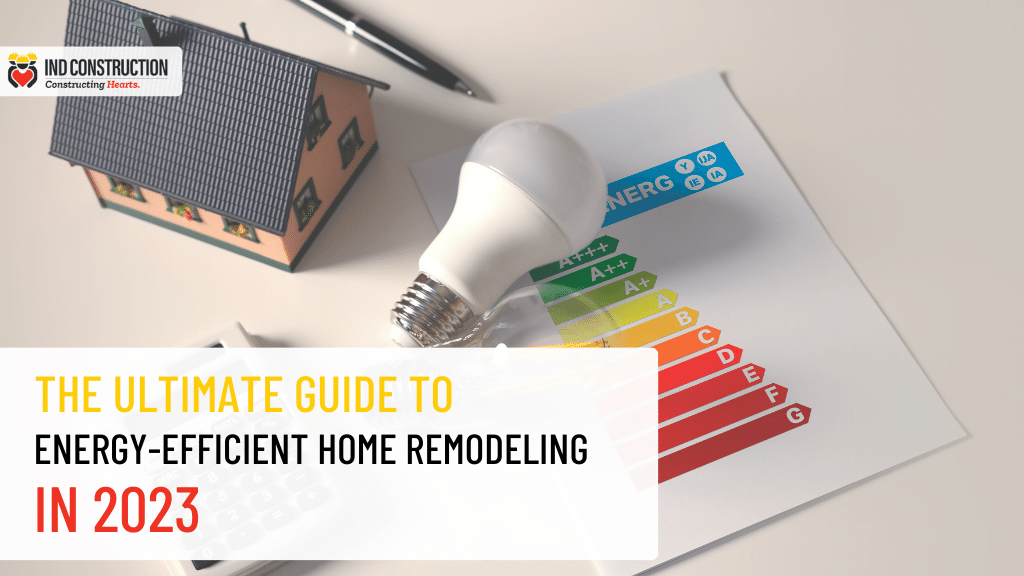Welcome to IND Construction, your trusted construction and remodeling company in California’s vibrant city of Los Angeles. As the leading experts in the industry, we are dedicated to providing you with the ultimate guide to energy-efficient home remodeling in 2023. This comprehensive guide will walk you through the key considerations and steps involved in transforming your home into an energy-efficient haven. Let’s delve into the world of energy efficiency and discover how you can make a positive impact on both your environment and your wallet.
1. Understanding Energy Efficiency
In today’s world, energy efficiency has become a paramount concern for homeowners. But what exactly does it mean? Energy efficiency refers to the utilization of technology and practices that aim to reduce energy consumption while maintaining optimal performance. By implementing energy-efficient measures, homeowners can enjoy several benefits, including lower utility bills, improved comfort, and reduced environmental impact.
2. Assessing Your Home’s Energy Efficiency
Before we dive into the realm of energy-efficient remodeling, it’s crucial to assess your home’s current energy efficiency. Conducting an energy audit is a great starting point. This audit will help identify areas where energy is being wasted and highlight opportunities for improvement.
During the energy audit, a professional will thoroughly inspect your home, examining elements such as insulation, windows, doors, heating and cooling systems, lighting, and appliances. By identifying potential areas of improvement, you can prioritize the most effective energy-saving upgrades for your home.
3. Energy-Efficient Windows and Doors
Windows and doors play a significant role in maintaining energy efficiency. Upgrading to energy-efficient windows can greatly reduce heat transfer, prevent drafts, and minimize the reliance on heating and cooling systems. Consider options such as double-glazed windows that provide improved insulation.
Proper installation techniques are essential for maximizing energy efficiency. Ensuring a tight seal and proper insulation around windows and doors will minimize air leakage and maintain a comfortable indoor environment.
4. Efficient Heating, Ventilation, and Cooling Systems
Heating, ventilation, and cooling systems (HVAC) account for a significant portion of a home’s energy consumption. Upgrading to high-efficiency HVAC systems can lead to substantial energy savings. Look for systems with a high Seasonal Energy Efficiency Ratio (SEER) and Annual Fuel Utilization Efficiency (AFUE) rating.
In addition to upgrading the equipment, installing programmable thermostats and smart controls allows for more precise temperature management, resulting in energy savings when you’re away from home or asleep.
Remember to schedule regular maintenance for your HVAC systems. Proper cleaning, filter replacement, and inspection will ensure optimal performance and energy efficiency.
5. Energy-Saving Lighting Solutions
Lighting is another area where homeowners can make a significant impact on energy consumption. Transitioning to LED lighting is a cost-effective and energy-efficient choice. LED bulbs last longer, consume less energy, and provide better lighting quality compared to traditional incandescent bulbs.
Take advantage of natural lighting whenever possible by maximizing the use of windows and skylights. Consider installing skylights and solar tubes to bring in more natural light, reducing the need for artificial lighting during the day.
6. Insulation and Air Sealing
Insulation is crucial for maintaining a comfortable indoor environment and reducing energy waste. There are various insulation materials available, including fiberglass, cellulose, and spray foam. Each material has its own unique benefits and applications, so it’s essential to choose the right one based on your specific needs.
Insulating walls, floors, and attics effectively prevents heat loss during the winter and heat gain during the summer. Combining insulation with proper air sealing techniques ensures that your home remains energy efficient by minimizing drafts and air leakage.
7. Sustainable Flooring Options
When it comes to flooring, there are eco-friendly choices that promote sustainability. Bamboo and cork flooring are popular options as they are renewable resources and have a low environmental impact. These materials also offer durability and a unique aesthetic appeal.
Recycled and reclaimed materials, such as reclaimed wood or recycled tiles, provide an opportunity to reduce waste and give a second life to materials that would otherwise end up in landfills. These flooring options not only contribute to energy efficiency but also add a touch of character to your home.
8. Water Conservation Measures
In addition to energy efficiency, it’s essential to consider water conservation measures during your remodeling project. Installing low-flow fixtures and faucets helps reduce water usage without compromising performance. Water-saving appliances, such as efficient dishwashers and washing machines, can further contribute to water conservation.
Consider incorporating rainwater harvesting systems into your landscape design. Collecting rainwater allows you to reuse it for irrigation purposes, reducing the demand for treated water.
9. Renewable Energy Sources
Harnessing renewable energy is a significant step towards achieving an energy-efficient home. Solar panels are an excellent investment for homeowners looking to reduce their reliance on traditional energy sources. By converting sunlight into electricity, solar panels provide a clean and sustainable energy solution.
When considering solar panel installation, assess your home’s solar potential. Factors such as the orientation of your roof, shading, and local weather patterns can affect the efficiency of your solar panels. Consult with professionals who can help determine the optimal placement and size of your solar system.
The benefits of solar energy extend beyond energy savings. Homeowners can take advantage of government incentives, such as tax credits and rebates, to offset the initial costs of installation. Additionally, generating your own clean energy reduces your carbon footprint and contributes to a greener environment.
10. Financing Energy-Efficient Remodeling
While energy-efficient remodeling offers long-term savings, the upfront costs can be a concern for homeowners. Fortunately, there are various financing options available to make energy-efficient upgrades more accessible.
Government programs and financial institutions often offer energy-efficient financing options that provide favorable terms and low-interest rates. Explore these options to find the most suitable financing solution for your remodeling project.
It’s also important to consider the return on investment (ROI) for energy-efficient upgrades. While the initial costs may seem high, the long-term savings on energy bills can offset those expenses over time. Calculate the potential savings and payback period to make an informed decision.
11. Hiring a Professional Contractor
Energy-efficient remodeling requires the expertise of a professional contractor who understands the intricacies of energy-efficient design and installation. Choosing the right contractor is crucial to ensure the success of your project.
Research credentials and experience when selecting a contractor. Look for certifications such as LEED (Leadership in Energy and Environmental Design) accreditation, which indicates their expertise in sustainable construction practices. Obtain multiple quotes and thoroughly evaluate each contractor’s proposals before making a decision.
Frequently Asked Questions (FAQs)
Q1: How much can I save on energy bills with energy-efficient remodeling?
A.Energy savings can vary depending on the extent of the remodeling and the specific upgrades implemented. However, it is common to see significant reductions in energy bills, often ranging from 20% to 50%.
Q2: What are the best materials for energy-efficient insulation?
A.Fiberglass, cellulose, and spray foam are commonly used insulation materials. Each material has its advantages, so it’s best to consult with professionals to determine the most suitable option for your home.
Q3: How long does it take to recoup the investment in solar panels?
A.The payback period for solar panels depends on several factors, including the cost of installation, energy consumption, and available incentives. On average, homeowners can recoup their investment within 5 to 10 years through energy savings.
Q4: Can I still achieve an energy-efficient home without a major remodel?
A.Absolutely! Energy efficiency can be achieved through various measures, both large and small. Simple changes like upgrading to energy-efficient appliances, improving insulation, and implementing smart energy-saving practices can make a significant difference.
Q5: Are there any government incentives available for energy-efficient remodeling?
A.Yes, there are several government incentives available to promote energy-efficient remodeling. These include tax credits, rebates, and grants at the federal, state, and local levels. Research available incentives in your area to take advantage of potential savings and financial support for your energy-efficient remodeling project.
Conclusion
In conclusion, energy-efficient home remodeling is a smart investment that not only benefits your wallet but also contributes to a sustainable future. By implementing energy-saving measures such as upgrading windows and doors, improving insulation, utilizing efficient heating and cooling systems, and incorporating renewable energy sources like solar panels, you can significantly reduce your energy consumption and environmental impact.
IND Construction is committed to providing top-notch construction and remodeling services that align with your energy-efficient goals. Our team of experienced professionals understands the unique needs of California residents and can guide you through every step of the remodeling process.
So why wait? Start your journey towards an energy-efficient home today with IND Construction. Together, let’s create a comfortable and sustainable living space that you can be proud of.




